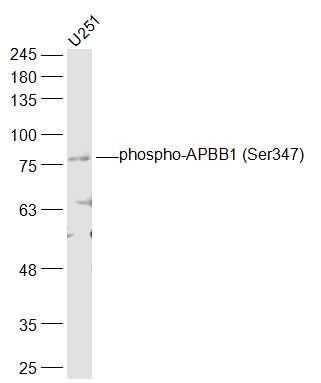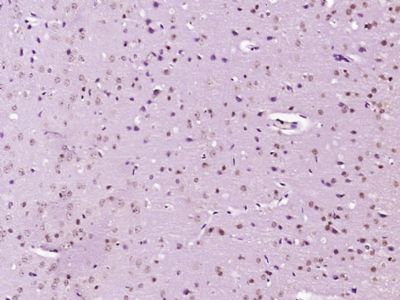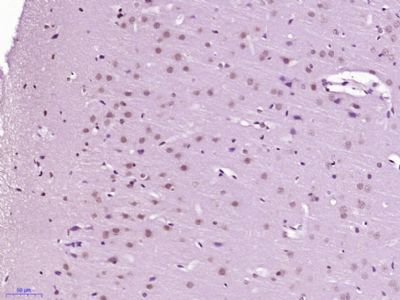产品中心
当前位置:首页>产品中心Anti-phospho-APBB1 (Ser347)
货号: bs-5166R 基本售价: 1580.0 元 规格: 100ul
产品信息
- 产品编号
- bs-5166R
- 英文名称
- phospho-APBB1 (Ser347)
- 中文名称
- 磷酸化铁蛋白Fe65抗体
- 别 名
- Adaptor protein FE65a2; Amyloid beta (A4) precursor protein binding family B member 1; Amyloid beta A4 precursor protein binding family B; Amyloid beta A4 precursor protein binding family B member 1; Amyloid beta precursor protein binding family B member 1; APBB 1; APBB1; FE 65; Fe65 protein; MGC 9072; MGC9072; Protein Fe65; RIR; Stat like protein; Fe-65 Protein; APBB1_HUMAN.
- 规格价格
- 100ul/1580元购买 大包装/询价
- 说 明 书
- 100ul
- 产品类型
- 磷酸化抗体
- 研究领域
- 肿瘤 免疫学 神经生物学 信号转导 细胞凋亡 转录调节因子
- 抗体来源
- Rabbit
- 克隆类型
- Polyclonal
- 交叉反应
- Human, Mouse, Rat, Dog, Pig, Cow, Horse, Rabbit,
- 产品应用
- WB=1:500-2000 ELISA=1:500-1000 IHC-P=1:400-800 IHC-F=1:400-800 IF=1:100-500 (石蜡切片需做抗原修复)
not yet tested in other applications.
optimal dilutions/concentrations should be determined by the end user.
- 分 子 量
- 77kDa
- 细胞定位
- 细胞核 细胞浆 细胞膜
- 性 状
- Lyophilized or Liquid
- 浓 度
- 1mg/ml
- 免 疫 原
- KLH conjugated Synthesised phosphopeptide derived from human APBB1 around the phosphorylation site of Ser347:SL(p-S)PE
- 亚 型
- IgG
- 纯化方法
- affinity purified by Protein A
- 储 存 液
- 0.01M TBS(pH7.4) with 1% BSA, 0.03% Proclin300 and 50% Glycerol.
- 保存条件
- Store at -20 °C for one year. Avoid repeated freeze/thaw cycles. The lyophilized antibody is stable at room temperature for at least one month and for greater than a year when kept at -20°C. When reconstituted in sterile pH 7.4 0.01M PBS or diluent of antibody the antibody is stable for at least two weeks at 2-4 °C.
- PubMed
- PubMed
- 产品介绍
- background:
The protein encoded by this gene is a member of the Fe65 protein family. It is an adaptor protein localized in the nucleus. It interacts with the Alzheimers disease amyloid precursor protein (APP), transcription factor CP2/LSF/LBP1 and the low-density lipoprotein receptor-related protein. APP functions as a cytosolic anchoring site that can prevent the gene products nuclear translocation. This encoded protein could play an important role in the pathogenesis of Alzheimers disease. It is thought to regulate transcription. Also it is observed to block cell cycle progression by downregulating thymidylate synthase expression. Multiple alternatively spliced transcript variants encoding different isoforms have been described for this gene.
Function:
Transcription coregulator that can have both coactivatorand corepressor functions. Adapter protein that forms atranscriptionally active complex with the gamma-secretase-derivedamyloid precursor protein (APP) intracellular domain. Plays acentral role in the response to DNA damage by translocating to thenucleus and inducing apoptosis. May act by specifically recognizingand binding histone H2AX phosphorylated on Tyr-142 (H2AXY142ph)at double-strand breaks (DSBs), recruiting other pro-apoptosisfactors such as MAPK8/JNK1. Required for histone H4 acetylation atdouble-strand breaks (DSBs). Its ability to specifically bindmodified histones and chromatin modifying enzymes such asKAT5/TIP60, probably explains its trancription activation activity.Function in association with TSHZ3, SET and HDAC factors as atranscriptional repressor, that inhibits the expression of CASP4.Associates with chromatin in a region surrounding the CASP4transcriptional start site(s).
Subunit:
Component of a complex, at least composed of APBB1,RASD1/DEXRAS1 and APP. Interacts (via PID domain 2) with APP (withthe intracellular domain of the beta-amyloid precursor protein).Interacts (via PID domain 2) with RASD1/DEXRAS1; impairs thetrancription activation activity. Interacts (via PID domain 1) withKAT5/TIP60. Interacts (via the WW domain) with the proline-richregion of APBB1IP. Interacts with TSHZ1 and TSHZ2 (By similarity).Interacts (via the WW domain) with histone H2AX (whenphosphorylated on Tyr-142) and the proline-rich region of ENAH.Interacts with MAPK8. Interacts (via PID domain 1) with TSHZ3 (viahomeobox domain). Interacts with SET. Found in a trimeric complexwith HDAC1 and TSHZ3; the interaction between HDAC1 and APBB1 ismediated by TSHZ3. Interacts (via WWW domain) with NEK6. Interacts(via WWW domain) with ABL1.
Subcellular Location:
Cell membrane. Cytoplasm. Nucleus. Cellprojection, growth cone (By similarity). Nucleus speckle.Note=Colocalizes with TSHZ3 in axonal growth cone (By similarity).In normal conditions, it mainly localizes to the cytoplasm, while asmall fraction is tethered to the cell membrane via its interactionwith APP. Following exposure to DNA damaging agents, it is releasedfrom cell membrane and translocates to the nucleus. Nucleartranslocation is under the regulation of APP. Colocalizes withTSHZ3 in the nucleus. Co-localizes with NEK6 at the nuclearspeckles. Phosphorylation at Ser-610 by SGK1 promotes itslocalization to the nucleus
Tissue Specificity:
Highly expressed in brain; strongly reduced inpost-mortem elderly subjects with Alzheimer disease.
Post-translational modifications:
Phosphorylation at Ser-610 by SGK1 promotes its localizationto the nucleus (By similarity). Phosphorylated following nucleartranslocation. Phosphorylation at Tyr-547 by ABL1 enhancestranscriptional activation activity and reduces the affinity forRASD1/DEXRAS1.
Similarity:
Contains 2 PID domains.
Contains 1 WW domain.
SWISS:
O00213
Gene ID:
322
Database links:Entrez Gene: 322 Human
Entrez Gene: 11785 Mouse
Entrez Gene: 29722 Rat
Omim: 602709 Human
SwissProt: O00213 Human
SwissProt: Q9QXJ1 Mouse
SwissProt: P46933 Rat
Unigene: 372840 Human
Unigene: 38469 Mouse
Unigene: 19953 Rat
Important Note:
This product as supplied is intended for research use only, not for use in human, therapeutic or diagnostic applications.
Fe65 蛋白(又称作Amyloid beta A4 precursor protein-binding family B member 1)可能与细胞内的APP结构域结合调节内源性的APP。
- 产品图片
 Sample:
Sample:
U251(Human) Cell Lysate at 30 ug
Primary: Anti-phospho-APBB1 (Ser347) (bs-5166R) at 1/1000 dilution
Secondary: IRDye800CW Goat Anti-Rabbit IgG at 1/20000 dilution
Predicted band size: 77 kD
Observed band size: 77 kD Paraformaldehyde-fixed, paraffin embedded (Mouse brain); Antigen retrieval by boiling in sodium citrate buffer (pH6.0) for 15min; Block endogenous peroxidase by 3% hydrogen peroxide for 20 minutes; Blocking buffer (normal goat serum) at 37°C for 30min; Antibody incubation with (phospho-APBB1 (Ser347)) Polyclonal Antibody, Unconjugated (bs-5166R) at 1:400 overnight at 4°C, followed by operating according to SP Kit(Rabbit) (sp-0023) instructionsand DAB staining.
Paraformaldehyde-fixed, paraffin embedded (Mouse brain); Antigen retrieval by boiling in sodium citrate buffer (pH6.0) for 15min; Block endogenous peroxidase by 3% hydrogen peroxide for 20 minutes; Blocking buffer (normal goat serum) at 37°C for 30min; Antibody incubation with (phospho-APBB1 (Ser347)) Polyclonal Antibody, Unconjugated (bs-5166R) at 1:400 overnight at 4°C, followed by operating according to SP Kit(Rabbit) (sp-0023) instructionsand DAB staining. Paraformaldehyde-fixed, paraffin embedded (Rat brain); Antigen retrieval by boiling in sodium citrate buffer (pH6.0) for 15min; Block endogenous peroxidase by 3% hydrogen peroxide for 20 minutes; Blocking buffer (normal goat serum) at 37°C for 30min; Antibody incubation with (phospho-APBB1 (Ser347)) Polyclonal Antibody, Unconjugated (bs-5166R) at 1:400 overnight at 4°C, followed by operating according to SP Kit(Rabbit) (sp-0023) instructionsand DAB staining.
Paraformaldehyde-fixed, paraffin embedded (Rat brain); Antigen retrieval by boiling in sodium citrate buffer (pH6.0) for 15min; Block endogenous peroxidase by 3% hydrogen peroxide for 20 minutes; Blocking buffer (normal goat serum) at 37°C for 30min; Antibody incubation with (phospho-APBB1 (Ser347)) Polyclonal Antibody, Unconjugated (bs-5166R) at 1:400 overnight at 4°C, followed by operating according to SP Kit(Rabbit) (sp-0023) instructionsand DAB staining.

